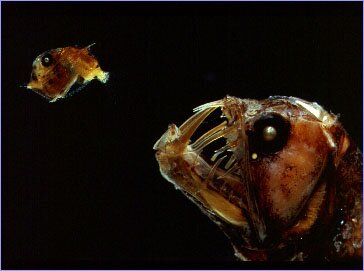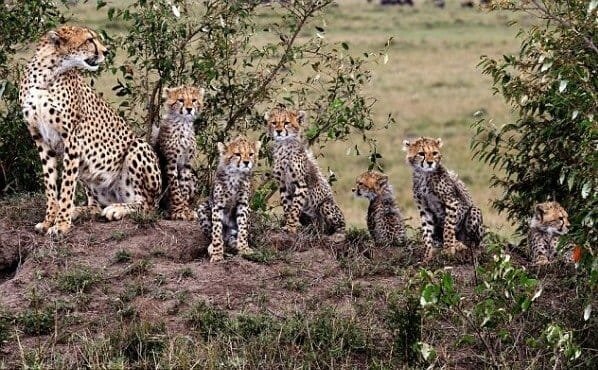Yet there are a few species that are more loathsome to our tastes. These are creatures straight out of nightmares – some more fangs than fish; others that look like they’ve barely swum out of the primeval sludge. But though we’d like to think we’re no relation to these demons of the deep, in the evolutionary scheme of things all us land vertebrates are derived from our fishy cousins.
1. Piranha Fish
While the threat this little teeth-with-gills poses to humans has been rather blown up in films – including its own self-titled horror B movie – the Piranha has a set of jaws to make any dentist nod with nervous approval. Its rows of razor-sharp gnashers are tightly packed and interlock with each other, teeth perfectly designed for the rapid piercing and shearing of meat – for which the Piranha has a rapacious appetite, as if you needed to know. The Piranha is also aggressive to its own kind and can become cannibalistic if underfed.
2. Anglerfish
Fish don’t come much more monstrous looking than the deep sea Anglerfish. Lurking far below the surface of the ocean, this bony beast of a fish is so called because of its distinctive method of catching prey using a fleshy lump that protrudes from its head like a fisherman’s lure. The Anglerfish is able to cheekily wiggle its growth so it appears as prey to other predators, the bait made even more alluring by the fact that it emits bright bioluminescent light. When the unsuspecting victim stays close enough, the anglerfish devours it whole, jaws triggered automatically by contact with the decoy.
3.Moray Eel
Found all over the world skulking in reef crevices – where it waits for prey to pass by near enough for it to lunge at and seize in its powerful jaws – the Moray Eel is a fish best steered clear of. This fearsome carnivore feeds on sea-dwelling creatures, but can also inflict severe injuries on people that get too close for comfort. Apparently the Moray is more often aloof than ill tempered, and will only attack humans in self-defence or bite hands by mistake if fed. When disturbed, however, it is vicious; and the bacteria coating its sharp backward-pointing teeth can infect wounds, making for an extra beastly bite.
4. Tigerfish
No prizes for guessing some of the reasons the Tigerfish got its name. With a gaping maw made up of an extremely well developed mouth with protruding teeth, this definitely isn’t the kind of fish you’d like to meet in a dark corner of the river. The Tigerfish is just as ferocious as it looks – fiercely territorial and known for being a voracious predator.
5.Snakehead Fish
Previously introduced in these columns when it was reported to have invaded Britain, the Snakehead fish can be one mean mother – quite literally as it’s thought to have attacked humans who have gone too close to its young. Widely distributed across South East Asia, parts of India and Africa, the giant tropical specimen boasts a fat mouth and sharp pointed teeth, and will eat just about everything in or on a body of water, be it fish, bird, amphibian or mammal.
6. Viperfish
Moving to the bottom five of our top ten, we come to the Viperfish, another predatory nasty with a snaky moniker. Rather like its bioluminescent buddy the Anglerfish, the Viperfish keeps to the ocean’s lower reaches. At night, though, this gruesome looking member the bottom feeding brotherhood swims to shallower depths of less than 700 feet where food is more available. Mercifully we wouldn’t fall into the F-word category were we ever to come face to face with the Pacific Viperfish – an extra large specimen that that may demonstrate deep-sea gigantism, reaching as long as 2 m.
7. Fangtooth Fish
Another cruel-faced deep-dwelling assassin, and one of the deepest-dwelling at that, the Fangtooth fish is found at murky depths as far as 5 km below the surface. Endowed with oversized fang-like teeth and a hefty jaw, the Fangtooth’s two largest lower fangs are so long the fish has a pair of sockets on either side of its tiny brain for the teeth to slot into when it shuts its mouth.
8. Dragonfish
The deep-sea horrors continue, and the Dragonfish has the by know familiar outsized mouth and fang-like teeth that are hallmarks of the abyssal beasts we’ve seen – but, hey, they’ve got to eat, and anything encountered will do. The Dragonfish’s head seems to be all jaw and eyes, but unlike its relative the Viperfish, it has a barbel that dangles from its chin and emits light to attract unwary prey, rather like the lure of the Anglerfish.
9. Gulper Eel
With a mouth much larger than its body – a mouth that makes the word enormous seem too tiny – the Gulper Eel swims into our midst, whip-like tail in tow. This bizarre and terrifying looking creature also goes by the name of Pelican Eel, and that massive pouch of a lower jaw makes it easy to see why. The mouth is slack-hinged, and can be opened wide enough for the Gulper to swallow creatures much larger than itself, while the gut of this freaky fish also stretches so it can stomach large meals.
10. Conger Eel
Finally, moving to slightly less bottomless depths, its time to get up close and personal with the Conger Eel. It may not have as many fancy tricks up its crevice as its cousin the Moray, but with its great size and none too pretty chops, the carnivorous Conger Eel busts its way into the top ten.

























